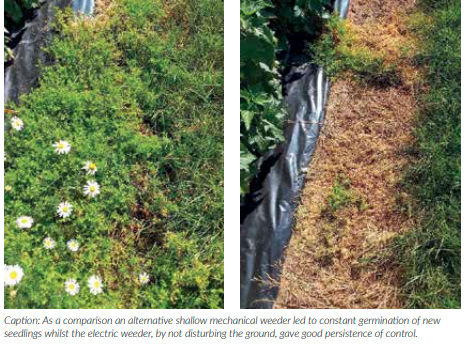A common question being asked by farmers looking at Conservation Agriculture is whether it can be done without
glyphosate. This is partly due to the possibility of its withdrawal but also because many farmers want to reduce all production costs and not become dependent on one input or technique. It is also a question being asked by organic farmers wanting to use less cultivations and increase use of cover crops without the need to plough every time.
The Innovative Farmers’ field lab ‘’Alternative methods for terminating cover crops’’ was sponsored by AHDB and run by ADAS researcher Helen Holmes. There were 5 trialists on 7 farms and each farm grew 2 standard covers plus others of their own choice making this trial their own.
The two control covers used were spring oats with oil radish and a bigger mix of phacelia, buckwheat, mustard and berseem clover. These were chosen as being readily available, cheap and almost standard seed mixes. The oats/radish mix is also frost tolerant. The individual farmers own choices included peas, oats and buckwheat and spring beans with phacelia. The poor autumn led to delayed drilling and poor germination which, followed by the cold spring meant that there were some crop failures, but this is an important part of the learning experiences associated with farmer-led trials. Many of these discoveries relate more to cover crop management than destruction but that also reflects how little we really know about such things.
The control termination techniques were glyphosate or plough(organic), crimper roller and Cambridge roll. Farmers own options were to graze with sheep, treat with liquid fertiliser or flail topper. All decisions about timings and actions were the farmers own but they were all asked to maintain similar protocols for all common control treatments. The trial plots were then drilled with spring crops following normal farm techniques and yields taken at harvest. Significantly none of the treatments reduced following crop yield compared with glyphosate.
Mechanical Cover Crop Termination
Using the Cambridge roller on a frost was for many a surprisingly successful treatment, especially since many farms have one, and wide widths make it a relatively quick method. Although 2 passes were visibly better, trial wise one was as effective. The Flail topper was effective at destroying covers but there was often regrowth because growing points were not destroyed. The fertiliser was ineffective, but it was considered that the application was too late and may have worked in conjunction with the crimper as a seedbed fertiliser application at drilling. Although not thought to be as effective as a roller overall, there was an indication that the crimper was more effective against radish, possibly by crushing the root top which then rotted.
For the organic farmer the importance of weed suppressing covers was plain but he did notice that there was a noticeable difference in tiller numbers across the trial plots on his farm.
He considers this due to different nitrogen residues left in the soil, something which also needs to be looked at as a potential additional source of nutrients for conventional farms. Overall the conclusion was that these alternatives were options to use as part of weed control strategies on farms either as alternatives to glyphosate or as a means of reducing glyphosate use. Potentially, it could lead to different pre or post emergence chemical methods being used in spring crops reducing the reliance on glyphosate.
This could be used as part of a strategy to reduce resistance risk. David White, one of the farmers, concluded that rolling did have the potential to reduce glyphosate usage to just one application before spring drilling which he considered to be worth discovering. He also sees Innovative Farmers as part of a learning experience and one of the benefits was the communication within the group, meeting and visiting other farmers and sharing positives as well as failures.
In the BASE UK supported trial, no-till and amendments for soil health, the role of Gypsum as a soil conditioner was investigated. The farmers had been applying gypsum regularly, but the trial looked at the process more scientifically and attempted to investigate differences across the field. The results showed positive effects of gypsum application on clay soils particularly with regards to soil bulk density and aggregation. It was noticeable that there was a better response on ‘poorer’ land within the field associated with more clay. A 2t/ ha application also lead to a reduction in penetrometer readings, indicating a reduction in compaction. In field results appeared to be better than those from a Lab.
NIAB have run a trial investigating increasing nutrient efficiency from anaerobic digestate. The issue is relating to effect of autumn application of nitrogen rich digestate rather than at the optimum time when crops are actively growing. First year results show that cover crops hold the nitrogen in the top layers of the soil or in their leaves and so there is significantly less risk of leaching, a potential problem with autumn applications. How much of that N is used by the following crops will determine how useful this practice is. The follow up trial anaerobic digestate impacts on soil microbiology and nitrogen retention will consider this as a natural progression of the trial as well as investigating effect of soil microbiology. This is an important consideration for farmers because independent research is essential to ensure that we take most benefit from new technologies. Although a potentially useful input, we still have a lot to learn about positives and negatives of digestate.
A further Innovative Farmers trial Electrical weeding for bush and cane fruit, appears a strange trial to highlight in an arable article. This is a European Agricultural Fund for Rural Development (EADRD) funded project investigating the potential for electricity to be used for weed control. These trials were in blackcurrants and chuckleberries (a cross between a redcurrant, a gooseberry, and a Jostaberry (itself a cross between a blackcurrant and a gooseberry)). The aim was to keep the so-called herbicide strip, half a metre either side of the base of the bush, weed free. Although herbicides are commonly used these trials, this investigated the potential to replace the herbicides or hand-weeding needed to make crop harvestable. The demand from the public for less chemicals in fruit production is also a factor in these trials.
Run by ADAS, these trials tested a prototype machine manufactured by Rootwave which used a PTO driven generator and transformers to get a high voltage, low amperage current to electrodes. These effectively create a circuit through the plant killing it by overheating the plant cells. Experimentally this has been shown to work on all plants except woody species and the trials investigated the effectiveness of weed control as well as working speed and persistence of control. Perennial weeds such as docks and thistles are a specific problem affecting mechanical harvesting of these crops, however grass weeds are also very competitive. The first year’s trial showed that the weeder struggled with a big biomass of grass scorching but not killing it, but it did demonstrate a 39% reduction in creeping thistle numbers. In the second year an additional newly planted field was added and so we were able to investigate effect on a wider range of annual weeds as well and results were very good as shown.

The trial also included a soil biology assessment to ensure that there were no negative effects on soil biota. A CO2 burst assessment showed no reduction in biological activity following treatment, and although this was expected because there is no direct contact with the electrodes, it had been a concern expressed by some. Fuel use was also measured and was found to be comparable with that of a sprayer tractor. Speed of operation and number of passes needed were part of the assessments being made with the prototype machinery in these trials. Initial results show that in a permanent crop situation multiple passes are needed, and slower passes increases efficacy, but that may be different in an annual rotational crop. Future development of the machine may have a different voltage reducing the number of passes required.
As a potential form of weed control in fruit crops these trials have demonstrated some potential but the interesting aspect is its potential application into arable crops. The ability to run the electrodes between row crops such as sugar beet or even cereal plants gives an alternative, nonchemical control which will kill even herbicide-resistant plants. Working under the crop canopy also has benefits. The effectiveness against rhizomatous weeds like thistles and couch grass has also good environmental benefits. There is also the potential to link this with weed sensing technology so that power is only used there is a weed to treat such as on above crop weeds like wild oats or bolted beet or at ground level with seedlings using robots.
All Innovative Farmer trials are available on the website www.innovativefarmers. org or follow the QR Code below, visitors need to log in, but access is free to all trials.
